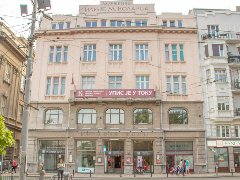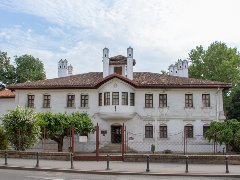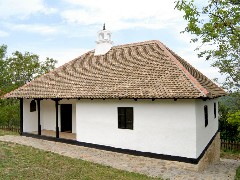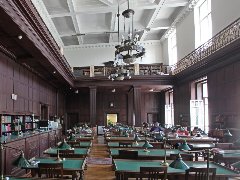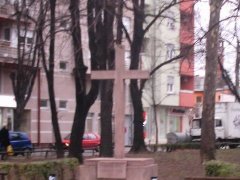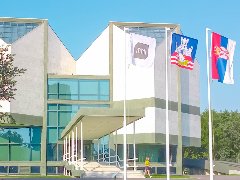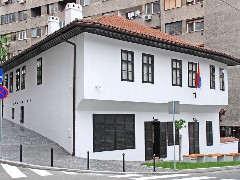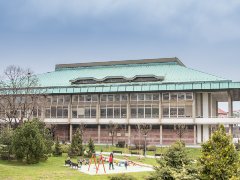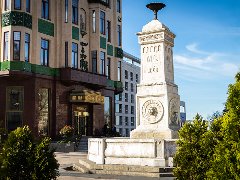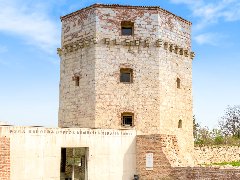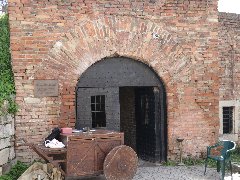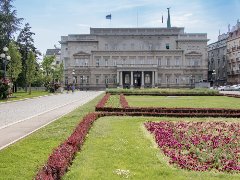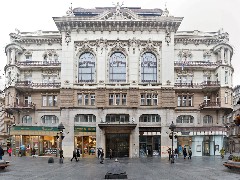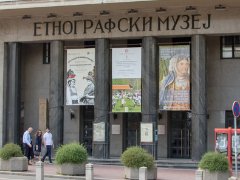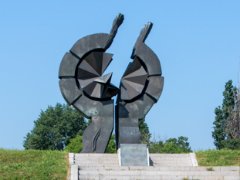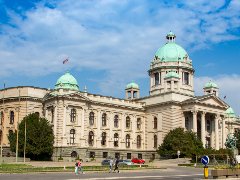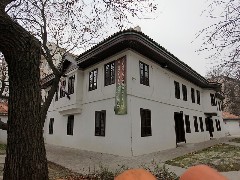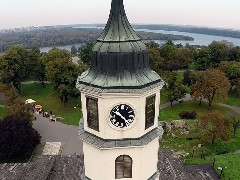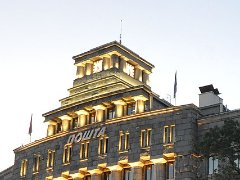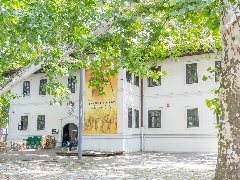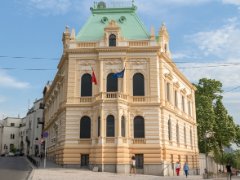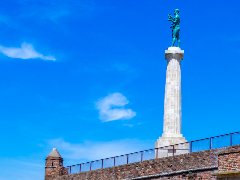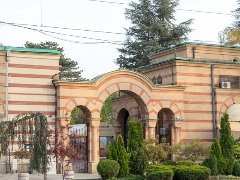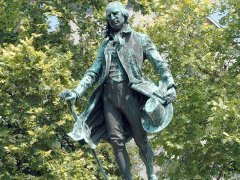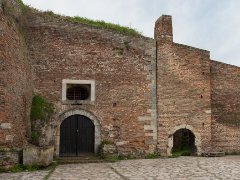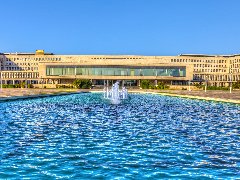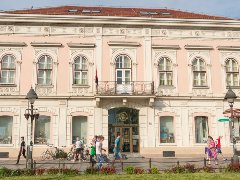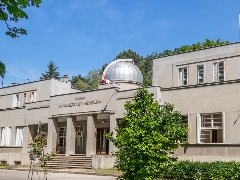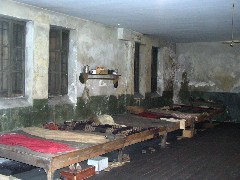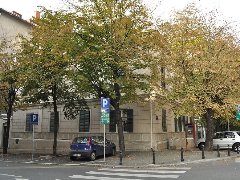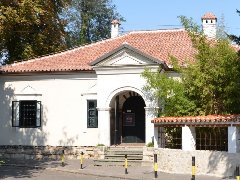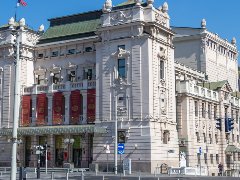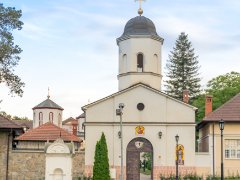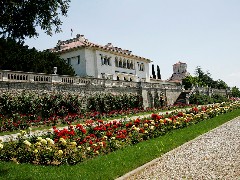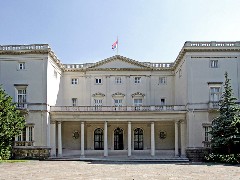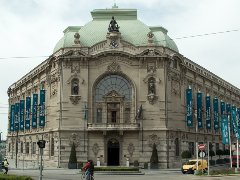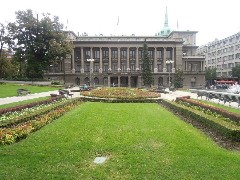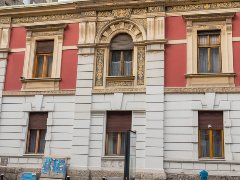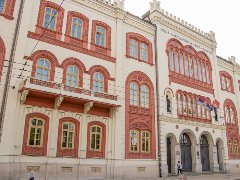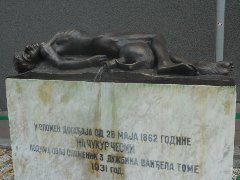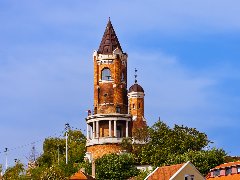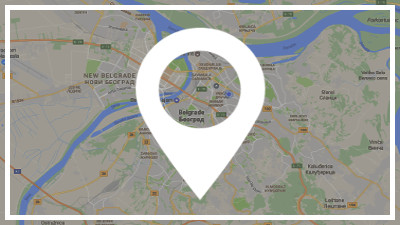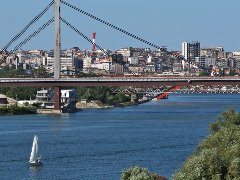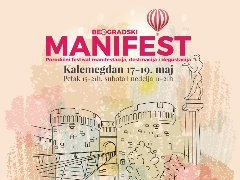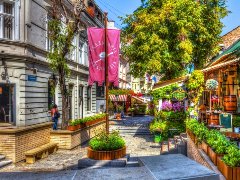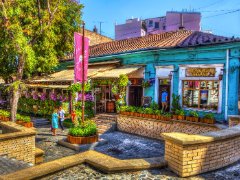WHAT TO SEE IN BELGRADE: CULTURAL MONUMENTS
Monuments of culture, spatial cultural and historical units, archaeological sites, famous places and other cultural goods of exceptional and great significance for the city
Kolarac's National University, or Kolarac Foundation, is an immobile cultural asset and represents an institution of great cultural and historical significance. In April 2013, the Ministry of Cultu...
Kolarac Endowment
Kolarac's National University, or Kolarac Foundation, is an immobile cultural asset and represents an institution of great cultural and historical significance. In April 2013, the Ministry of Cultu...
The Residence of Princess Ljubica is one of few buildings surviving from the first reign of Prince Milosh Obrenovic. It was built between 1829 and 1831 according to the project and under the superv...
The Residence of Princess Ljubica
The Residence of Princess Ljubica is one of few buildings surviving from the first reign of Prince Milosh Obrenovic. It was built between 1829 and 1831 according to the project and under the superv...
The birth house of field marshal Stepa Stepanović in Kumodraž, where the renowned military commandment, a general and field marshal who participated in all wars from 1876 till 1918 in which Serbia ...
The birth house of Stepa Stepanovic
The birth house of field marshal Stepa Stepanović in Kumodraž, where the renowned military commandment, a general and field marshal who participated in all wars from 1876 till 1918 in which Serbia ...
The library was officially opened in 1921, although it has long played an important role for the academic development of the country. The World War I led to the irrecoverable loss of diverse litera...
Svetozar Markovic University Library
The library was officially opened in 1921, although it has long played an important role for the academic development of the country. The World War I led to the irrecoverable loss of diverse litera...
An eminent bookshop owner and printer, Gligorije Vozarevic (1790-1848), in his field on Vracar, in 1847, built a red cross embellished with icons. The symbol of victory and freedom is also the firs...
Vozarev Cross
An eminent bookshop owner and printer, Gligorije Vozarevic (1790-1848), in his field on Vracar, in 1847, built a red cross embellished with icons. The symbol of victory and freedom is also the firs...
According to the project of the architectural duo, Ivanka Raspopovic and Ivan Antic, the museum was built from 1960 to 1965. Miodrag B. Protic is the founder, and at the very opening he received gr...
Museum of Contemporary Art Belgrade
According to the project of the architectural duo, Ivanka Raspopovic and Ivan Antic, the museum was built from 1960 to 1965. Miodrag B. Protic is the founder, and at the very opening he received gr...
Manak's house was built about 1830 in Savamalska Street, on the old road that connected Varos-kapija and the old Belgrade quarter of Savamala. One of the owners of the house was Manak Mihailovic, a...
Manak's house
Manak's house was built about 1830 in Savamalska Street, on the old road that connected Varos-kapija and the old Belgrade quarter of Savamala. One of the owners of the house was Manak Mihailovic, a...
The National Library of Serbia was built between 1966 and 1972 after the design by architect Ivo Kurtovic. The author conceived it as a free standing, detached, building in the area around St. Sava...
The National Library of Serbia
The National Library of Serbia was built between 1966 and 1972 after the design by architect Ivo Kurtovic. The author conceived it as a free standing, detached, building in the area around St. Sava...
Designed by Franz Loran, the Terazije Fountain was erected in 1860 to mark the return to the throne of Prince Milos Obrenovic. It was fashioned in the tomantic style and represents one of the most ...
Terazije fountain
Designed by Franz Loran, the Terazije Fountain was erected in 1860 to mark the return to the throne of Prince Milos Obrenovic. It was fashioned in the tomantic style and represents one of the most ...
Nebojsa Tower represents the only remaining well preserved medieval building within the Belgrade Fortress. It was built around 1460 and belongs to the oldest type of early artillery canon towers. W...
Nebojsa Tower
Nebojsa Tower represents the only remaining well preserved medieval building within the Belgrade Fortress. It was built around 1460 and belongs to the oldest type of early artillery canon towers. W...
The well was built during the baroque Austrian reconstruction of the Fortress, in the period between 1717 until 1731, when it was named "The Big Well". The name "Roman Well", first mentioned in the...
Roman Well
The well was built during the baroque Austrian reconstruction of the Fortress, in the period between 1717 until 1731, when it was named "The Big Well". The name "Roman Well", first mentioned in the...
The Old Palace, the residence of the Serbian Obrenovic dynasty, was built in the period between 1882 and 1884, according to the design of Aleksandar Bugarski in the architectual style of academism....
Old Palace
The Old Palace, the residence of the Serbian Obrenovic dynasty, was built in the period between 1882 and 1884, according to the design of Aleksandar Bugarski in the architectual style of academism....
The building of the Serbian Acadamy of Sciences and Arts (SANU) was constructed in the academic style with elements of Art Nouveau in 1924. It is the work of Dragutin Djordjevic and Andra Stevanovi...
Serbian Academy of Sciences and Arts
The building of the Serbian Acadamy of Sciences and Arts (SANU) was constructed in the academic style with elements of Art Nouveau in 1924. It is the work of Dragutin Djordjevic and Andra Stevanovi...
The Ethnographic Museum houses a large number of ethnographic items, divided into separate exhibits (household items, jewellery, customs, national costumes, national architecture, economy, stock fa...
Ethnographic museum
The Ethnographic Museum houses a large number of ethnographic items, divided into separate exhibits (household items, jewellery, customs, national costumes, national architecture, economy, stock fa...
The site that became the Sajmiste concentration camp during World War II had originally been an exhibition centre built by the Belgrade municipality in 1937in an attempt to attract international co...
Staro Sajmiste & Contrentation Camp
The site that became the Sajmiste concentration camp during World War II had originally been an exhibition centre built by the Belgrade municipality in 1937in an attempt to attract international co...
The National Assembly Building was built in the vicinity of the place where the Grand National Assembly Meeting was held in November 30, 1830. At the gathering, the Turkish sultan’s imperial Edict ...
National Assembly Building
The National Assembly Building was built in the vicinity of the place where the Grand National Assembly Meeting was held in November 30, 1830. At the gathering, the Turkish sultan’s imperial Edict ...
In 1949 Vuk’s collection has been separated from the National Museum collection and joined the small legacy of Dositej Obradovic. On February 28, 1949 The Museum of Vuk and Dositej was formed and o...
The museum of Vuk and Dositej
In 1949 Vuk’s collection has been separated from the National Museum collection and joined the small legacy of Dositej Obradovic. On February 28, 1949 The Museum of Vuk and Dositej was formed and o...
Sahat Tower, located above the gate which was named "Sahat Gate" after it, was built during the period between 1740 and 1789. The overall appearance of the tower, with prominent baroque elements, d...
Sahat Tower
Sahat Tower, located above the gate which was named "Sahat Gate" after it, was built during the period between 1740 and 1789. The overall appearance of the tower, with prominent baroque elements, d...
Main Post Office Building in Belgrade is located on the corner of Takovska Street and King Aleksandar Boulevard
Main Post Office Building
Main Post Office Building in Belgrade is located on the corner of Takovska Street and King Aleksandar Boulevard
The construction of the residence within the court complex in Topcider lasted from 1831 to 1834. Immediately after the completion of the works, the residence (Konak) assumed the role of the officia...
Residence of Prince Milos
The construction of the residence within the court complex in Topcider lasted from 1831 to 1834. Immediately after the completion of the works, the residence (Konak) assumed the role of the officia...
It was built in 1898 as a representative family house on a plot of very sharp corner whose central facade became the bearer of further construction in Belgrade in the style of Academic art.
House of Dimitrije Krsmanovic
It was built in 1898 as a representative family house on a plot of very sharp corner whose central facade became the bearer of further construction in Belgrade in the style of Academic art.
Belgrade Fortress is located on top of the cliff-like ridge overlooking the confluence of the Sava and the Danube. This is the last raised ground in the Balkan Peninsula that controls the access to...
Belgrade fortress
Belgrade Fortress is located on top of the cliff-like ridge overlooking the confluence of the Sava and the Danube. This is the last raised ground in the Balkan Peninsula that controls the access to...
Back in 1983, it was proclaimed a historical and cultural good of great importance for Serbia. The "Association of culturally important cemeteries of Europe" has included the New Cemetery in its li...
New cemetery
Back in 1983, it was proclaimed a historical and cultural good of great importance for Serbia. The "Association of culturally important cemeteries of Europe" has included the New Cemetery in its li...
Dositej Obradovic was born in Cakovo in 1739, (or in 1742 or 1744) and died in 1811 in Belgrade. The monument was built in 1914 at the initiative of Jovan Skerlic and Srpska knjizevna zadruga (the ...
Monument to Dositej Obradovic
Dositej Obradovic was born in Cakovo in 1739, (or in 1742 or 1744) and died in 1811 in Belgrade. The monument was built in 1914 at the initiative of Jovan Skerlic and Srpska knjizevna zadruga (the ...
It was built during the great Austrian reconstruction of the Belgrade Fortress between 1718 and 1720. The goal was to make a safe powder shelter, a place protected from the enemy artillery. It was ...
Big Gunpowder Magazine
It was built during the great Austrian reconstruction of the Belgrade Fortress between 1718 and 1720. The goal was to make a safe powder shelter, a place protected from the enemy artillery. It was ...
It was built in 1959 to be used by the Federal Executive Council of Yugoslavia. It was informally known as the Palace of the Federation (Palata Federacije) before given its present name. The repre...
Palace of Serbia
It was built in 1959 to be used by the Federal Executive Council of Yugoslavia. It was informally known as the Palace of the Federation (Palata Federacije) before given its present name. The repre...
The Belgrade City Library was originally built as the Srpska Kruna (Serbian Crown) hotel, in Romantic style, in 1869. At the time it was the most modern and best equipped hotel in Belgrade, built b...
Belgrade City Library
The Belgrade City Library was originally built as the Srpska Kruna (Serbian Crown) hotel, in Romantic style, in 1869. At the time it was the most modern and best equipped hotel in Belgrade, built b...
Belgrade Astronomical Observatory is one of the oldest scientific institutions in Serbia. The decree of its founding conjointly with the Meteorological Observatory was signed on April 7th, 1887 by ...
Astronomical observatory of Belgrade
Belgrade Astronomical Observatory is one of the oldest scientific institutions in Serbia. The decree of its founding conjointly with the Meteorological Observatory was signed on April 7th, 1887 by ...
In this camp formed in the complex of the old barracks, between 1941 and 1944, the Nazi occupier committed a large number of crimes - approximately 4.200 detainees were executed, most of them Serbs...
Museum of the Banjica Concentration Camp
In this camp formed in the complex of the old barracks, between 1941 and 1944, the Nazi occupier committed a large number of crimes - approximately 4.200 detainees were executed, most of them Serbs...
The courtyard house was built between 1878 and 1883. Since the end of the 19th century, the family Veljkovic has left an indelible mark with its active commitment to the overall social development....
House of the family Veljkovic
The courtyard house was built between 1878 and 1883. Since the end of the 19th century, the family Veljkovic has left an indelible mark with its active commitment to the overall social development....
Located in Bozic's house, built in 1836 by pig merchant Miloje Bozic, which is itself a cultural monument. The museum keeps theater material that testifies to the development of the theater in Serb...
Museum of Theater Arts of Serbia
Located in Bozic's house, built in 1836 by pig merchant Miloje Bozic, which is itself a cultural monument. The museum keeps theater material that testifies to the development of the theater in Serb...
The desire to establish a permanent professional theater in Belgrade dates back to 1841. After almost three decades of performing plays at various places in the capital, on 18th August, 1868, Princ...
National Theatre
The desire to establish a permanent professional theater in Belgrade dates back to 1841. After almost three decades of performing plays at various places in the capital, on 18th August, 1868, Princ...
The monastery belongs to the Archdiocese of Belgrade-Karlovac and is dedicated to Archangels Michael and Gabriel (Mihailo and Gavrilo). From the 16th century, it is located in the present place and...
Manastir Rakovica
The monastery belongs to the Archdiocese of Belgrade-Karlovac and is dedicated to Archangels Michael and Gabriel (Mihailo and Gavrilo). From the 16th century, it is located in the present place and...
The Royal Palace in Dedinje was built between 1924 and 1929, on the orders by King Alexander I, as the official royal residence. It is a spacious and representative villa built of white stone in th...
Royal Palace
The Royal Palace in Dedinje was built between 1924 and 1929, on the orders by King Alexander I, as the official royal residence. It is a spacious and representative villa built of white stone in th...
The White Palace (Beli Dvor) is located within the same copmplex as The Royal Palace. King Alexander I built The White Palace with its own private funds, as the residence for his three sons: Peter ...
White palace
The White Palace (Beli Dvor) is located within the same copmplex as The Royal Palace. King Alexander I built The White Palace with its own private funds, as the residence for his three sons: Peter ...
This architectural beauty was built in 1907 and is a work of two, Nikola Nestorovic and Andre Stankovic. As it is visibly influenced by French esthetics, the reason for that is the creators' visit ...
Geozavod (Belgrade Cooperative)
This architectural beauty was built in 1907 and is a work of two, Nikola Nestorovic and Andre Stankovic. As it is visibly influenced by French esthetics, the reason for that is the creators' visit ...
The New Palace was built in a period from 1911 to 1922 as a royal residence of the Karadjordjevic dynasty. Laid out as an architectural counterpart of the Old Palace, the new royal residence histor...
New Palace
The New Palace was built in a period from 1911 to 1922 as a royal residence of the Karadjordjevic dynasty. Laid out as an architectural counterpart of the Old Palace, the new royal residence histor...
In the very center of Belgrade, a unique house with over two centuries of tradition, tells many stories and hides secrets of one of the most prominent diplomatic families in Serbia. Meet "Serbian M...
Jevrem Grujic's house
In the very center of Belgrade, a unique house with over two centuries of tradition, tells many stories and hides secrets of one of the most prominent diplomatic families in Serbia. Meet "Serbian M...
A magnificent building that keeps the spirit of Belgrade from the 19th century. It was built for 6 years, from 1857 until 1863, so it was a unique architectural landmark even at the time of constru...
Captain Misa Mansion
A magnificent building that keeps the spirit of Belgrade from the 19th century. It was built for 6 years, from 1857 until 1863, so it was a unique architectural landmark even at the time of constru...
It represents a monument built in memory of a sad incident when Turkish soldiers killed a little apprentice - a boy called Sava Petkovic on 15th June 1862. There is his statue on the fountain and t...
Cukur fountain
It represents a monument built in memory of a sad incident when Turkish soldiers killed a little apprentice - a boy called Sava Petkovic on 15th June 1862. There is his statue on the fountain and t...
It was built in 1896 to mark 1,000 years Hungarians stays in Pannonia region. For the Millennium Tower, it can be freely said that to this day it causes an avalanche of blunders and doubts as to it...
Millenium Tower
It was built in 1896 to mark 1,000 years Hungarians stays in Pannonia region. For the Millennium Tower, it can be freely said that to this day it causes an avalanche of blunders and doubts as to it...
RELATED CONTENT
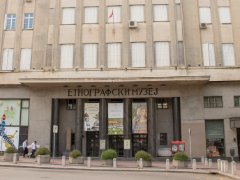
Voluntary blood donation at the Ethnographic Museum
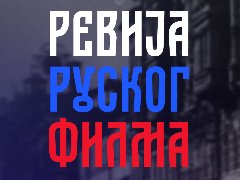
Russian Film Review at the Ethnographic Museum
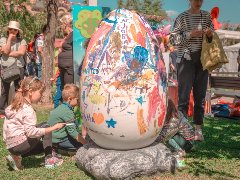
Great Easter Carnival in Belgrade this spring
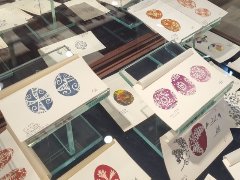
The 500 new keepers of tradition at the Ethnographic Museum

Belgrade Days 2025
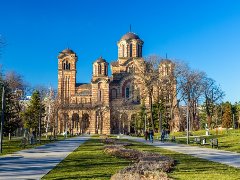
Today is Lazarus Saturday - Vrbica

Open Day at Manak's House

Familijada - Family Feud at the Museum of Illusions creates real family magic
LATEST NEWS

Voluntary blood donation at the Ethnographic Museum

Russian Film Review at the Ethnographic Museum

Great Easter Carnival in Belgrade this spring
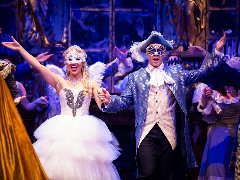
"Phantom of the Opera" premiere on April 22nd and meeting the cast

The 500 new keepers of tradition at the Ethnographic Museum
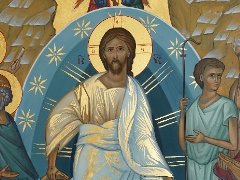
Icon Exhibition at the Green Door Gallery

Belgrade Days 2025

